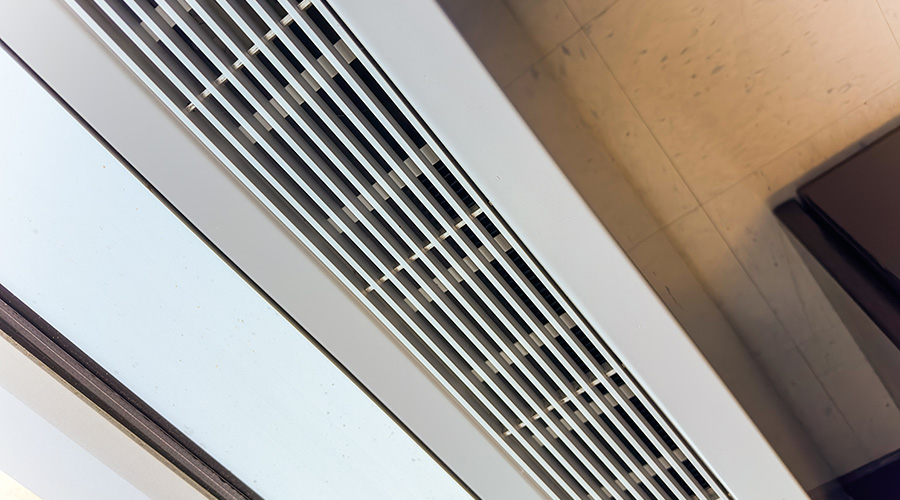IAQ: What You Can Do
These four steps can help managers improve indoor air quality and, possibly, enhance worker productivity
Engineering and maintenance managers are pushing today for commercial and institutional building designs that can provide a high-quality indoor environment while at the same time using less energy than older, comparable buildings.
One obstacle they must overcome is the widespread skepticism among top management that the increased construction and renovation costs that might result from these designs are worthwhile investments that will provide a positive rate of return over the life of the facility.
Fortunately, a number of studies conducted over the past 15 years support their position, particularly when it comes to the link between proper indoor air quality (IAQ) and increased occupant productivity. While this has been a long held intuitive belief, these studies demonstrate that the relationship between IAQ and productivity is real and positive.
The Productivity Issue
The studies also have shown that the impact of poor IAQ has been overlooked because it was hidden in such factors as more sick days, higher medical costs and lower occupant productivity. For example, a study of 100 U.S. office buildings found that 23 percent of workers in those buildings experienced frequent respiratory ailments, allergies, and asthma — all symptoms of sick building syndrome. The economic impact of the symptoms was a reduction in productivity of about 2 percent.
Numerous other studies have shown that improvements made in IAQ can reduce incidences of sick building syndrome by 20-50 percent. The resulting improvement in building occupant productivity is about 0.5-20 percent.
Even something as simple as better regulation of indoor air temperatures affects productivity. One study conducted in Japan showed that an increase in summer indoor air temperature of 1.8 degrees resulted in a productivity drop of 2.1 percent. Another study by Cornell University showed that poor regulation of temperatures within workspaces resulted in an increase in the number of errors by occupants and an increase in hourly labor costs of 10 percent.
The conclusions from these and other studies on the impact of IAQ on productivity can be summarized as follows:
• The impact that IAQ has on building occupant productivity is positive and can be measured.
• By maintaining proper IAQ, the magnitude of productivity improvement is typically 5-15 percent.
• Facilities with good IAQ can expect to have reduced absenteeism by up to 40 percent.
• There is a very positive rate of return on IAQ investment.
With labor costs making up a substantial portion of a facility’s annual operating cost, it makes sense to focus on improving IAQ as a means of enhancing productivity.
Managers can use a range of measures to improve IAQ in new and existing buildings, but the measures must match the specific requirements of the application if they are to be effective and cost-efficient.
Resize the HVAC system
The first step is to confirm that the HVAC system is properly sized for the activities occupants perform in the space. The system once might have been the proper size, but changes in the way occupants use the facility and the functions they perform within the facility can affect HVAC system requirements, resulting in a system that is undersized, oversized or simply cannot meet the needs of building occupants.
Similarly, systems might perform as intended when they are new, but time and operation take their toll. Systems go out of calibration. Dirt accumulates on coils and in ductwork, reducing performance and providing a medium for the growth of organisms. Improper or inadequate maintenance can result in insufficient airflow or inadequate temperature and humidity controls.
Technicians need to audit the operation of the HVAC systems throughout the facility. Identify areas where system performance fails to meet the needs of occupants. Review IAQ complaints from the occupants, and investigate the causes.
Determine if corrections can be made through maintenance activities or if a system overhaul or replacement is required. Develop a list of all required actions. If IAQ issues have not been a priority in the past, chances are it will be necessary to re-prioritize items on the list for action.
In most facilities, a good percentage of the IAQ problems can be corrected by performing the necessary maintenance activities. Measures such as cleaning of coils and ductwork, rebalancing of systems, and calibrating controls will help to correct many common IAQ problems.
But not all IAQ problems can be corrected simply by performing maintenance tasks. Some will require modifications to the existing systems depending on the types of problem. Fortunately, maintenance and engineering managers have a range of options available to them that will address the most common IAQ problems.
Rethink Air Filtration
Proper air filtration plays a very important role in maintaining good IAQ. Many older HVAC system designs provide adequate filtration to protect the system’s coils and other equipment but not enough protection by today’s standards for building occupants.
Advances in both filtration designs and techniques have resulted in the ability to supply cleaner, purer air to building spaces.
By properly selecting the filtration media to match the space requirements, system performance can be enhanced to the level required by occupants and operations without resulting in a large increase in system energy requirements.
In special applications where exposure of the building occupants to biological contaminants is a risk, ultraviolet germicidal irradiation units can be added to the filtration system.
Ultraviolet light has been effective in killing many types of mold and bacteria commonly found in buildings and HVAC systems. In addition to improving IAQ for the building occupants, the systems have been found to limit the growth of microorganisms on HVAC system cooling coils, as well as to help reduce static pressure losses across the coils due to dirt buildup.
Regulate Temperatures
Ever since the energy crisis of the 1970s, many facilities have followed a policy of not allowing building occupants to set their own space temperatures. Accessible thermostats were placed in locking enclosures. To reduce energy requirements, it was commonly mandated that the thermostats be set to an established temperature, typically 68 degrees during the heating season and 76 or 78 degrees during the cooling season.
The theory was that the tactic would reduce heating and cooling energy use since building occupants no longer could overheat or overcool their spaces. The problem with this theory is that did not take into account the impact of comfort on productivity.
Instead of mandating arbitrary setpoints for thermostats that users cannot adjust, managers might consider installing thermostats with a limited range of adjustment so that users would have some control over the temperature in their spaces. While on the average this would result in a slight increase in energy use, it would be more than offset by an increase in productivity.
Emphasize Maintenance
These and other system changes can improve IAQ and productivity, but their performance is only as good as their maintenance. While proper maintenance is important for the proper operation and performance of building components, it is critical for maintaining good IAQ. Without proper, regular maintenance, system performance will rapidly decline, taking with it both the quality of the air in the facility and the productivity of the building occupants.
James Piper, P.E., is a national consultant with more than 25 years of experience in facilities and maintenance management.
Related Topics:











